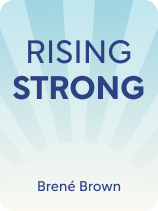

This article is an excerpt from the Shortform book guide to "Rising Strong" by Brené Brown. Shortform has the world's best summaries and analyses of books you should be reading.
Like this article? Sign up for a free trial here.
Want to know how to process trauma on your own? How do you explore a traumatic event?
A part of the recovery process is exploring your narrative about a situation. In Rising Strong, Brené Brown says that you must identify whether that narrative might differ from reality.
Keep reading to learn how to process trauma by navigating your feelings toward it.
Explore What Happened
Learning how to process trauma on your own means exploring a situation thoroughly. When we experience something painful, our brains try to determine what happened and why in an attempt to avoid ambiguity. However, we don’t usually have all the important information about the situation—such as someone’s true feelings, intentions, or reasons. Therefore, we tend to assume the worst about what happened and why based on our negative past experiences. This creates an inaccurate narrative.
(Shortform note: Scientists explain that humans have a tendency to avoid ambiguity and make assumptions because doing so gives us an evolutionary advantage. Ambiguity leaves us unable to concretely prepare for the future, which makes us more likely to be surprised by events and possibly harmed. The human brain adapted to avoid ambiguity and its potential danger by making assumptions. Further, we’re more likely to make negative assumptions when faced with uncertainty because, to effectively protect ourselves, we’re better off preparing for the worst than assuming the best and being blindsided.)
Relying on negative, inaccurate narratives often fosters negative feelings about ourselves and others. This keeps us from embracing our authentic selves, being open with others, and recovering wholeheartedness. For example, we might assume that someone’s intent was to hurt us or that they acted in a certain way because we weren’t good enough.
On the other hand, when you learn how to confront trauma on your own and its potential inaccuracies, you’re able to identify and combat your negative assumptions. This gives you a more balanced perspective of the situation and those involved in it so you’re better equipped to recover from setbacks and re-embrace wholeheartedness.
(Shortform note: Confronting our narrative and its potential inaccuracies may be crucial to overcoming our negative assumptions because it combats confirmation bias—our tendency to favor information that confirms our beliefs and assumptions and reject information that doesn’t. In the context of Brown’s process, confirmation bias may encourage us to look for “evidence” that supports our assumed narrative about a situation. When we look for flaws in the narrative instead, we actively challenge our beliefs about what happened. This can leave us better equipped to deconstruct our confirmation bias and see the reality of a situation from all angles.)
Further, learning to overcome these assumption reactions will boost your resilience—your ability to avoid or quickly recover from emotional setbacks in the future. This is because the more you practice deconstructing your inaccurate narratives, the easier it will get and the better you’ll become at preventing yourself from creating them in the first place.
| Negative Assumptions and Uncertainty Tolerance As Brown notes, we often make assumptions (and therefore experience their negative effects) when faced with stress-inducing ambiguity. You may be able to avoid the negative consequences of making assumptions if you increase your uncertainty tolerance (UT)—your ability to tolerate ambiguity without making any assumptions, good or bad. Having higher UT is correlated with improved overall well-being, higher self-esteem, higher motivation to take social risks (like being open and connecting with others), and higher life satisfaction. Further, some research suggests that people who have a high tolerance for ambiguity cope better when faced with chance events—in other words, they have more resilience in the face of setbacks. One way to increase your UT is by developing “flexible thinking”—the ability to go with the flow when you know you can’t control things but quickly shift your approach when you learn new, relevant information about the situation. |
Brown recommends three steps to explore what happened to you and identify what you need to learn so you can rebuild wholeheartedness.
Step #1: Record Your Initial Narrative
First, Brown says to record the initial narrative you’re telling yourself about the situation—what occurred, your beliefs about why it occurred, and what the situation made you think and feel. In doing so, be as truthful about your feelings as possible—you might feel crazy or unhinged if your story seems unreasonable, but that’s OK. For example, your story about your spouse missing your award ceremony might look something like this:
“My spouse missed my award ceremony because they’re selfish, and they didn’t want to go—being sick was just an excuse. Even if they were sick, they could have attended a short ceremony. If the roles were reversed, I would have pushed through for them. I must not be very important to them, and I must love them more than they love me.”
(Shortform note: Other experts also emphasize the importance of writing down your assumptions to help overcome them, and they recommend a specific exercise to help you get into the practice. For one week, write down every assumption you make, no matter how minor. For example, if you can’t find the screwdriver and assume it’s because your partner misplaced it, write it down—even if it doesn’t cause an emotional setback. Doing this exercise for one week will help you to recognize your assumptions in more critical situations like emotional setbacks and get you into the habit of recording them immediately.)
Step #2: Look Outward
Second, Brown says you must analyze the situation and determine what else you need to know to get a complete and accurate perspective. First, identify which parts of your story are objective facts and which are assumptions. Then, consider what else you need to know about the other people involved to get an accurate picture of the situation—do you need more information, to ask questions, or to clarify anything?
For example, the facts of the situation are that your spouse didn’t attend the ceremony, and they told you it was because they were sick. Your assumptions are that the sickness was an excuse, and your spouse doesn’t care about you as much as you care about them. To get the full story, you need to know more about whether your spouse was truly sick, and if they truly wanted to attend the ceremony.
Finally, consider how your initial narrative may have been inaccurate due to the assumptions you made. Consider whether the assumptions are fair, and why. For instance, maybe believing that your spouse’s sickness was fake was an unfair assumption—they’ve never faked an illness before, and you can’t step into their body to measure how well they feel.
| Handling Challenging Conversations About Assumptions and Conflicts The reflection process Brown outlines may require you to have a challenging or emotionally charged conversation with the other person involved. You may need to ask them clarifying questions about their actions and intentions. In doing so, you may need to admit that you initially assumed the worst of their behavior—and created a negative narrative as a consequence. Handled poorly, this type of conversation may upset the other person: They may feel like you’re interrogating them, or they may be hurt that you assumed they had bad intentions. Here are some tips for handling these kinds of challenging conversations: Get permission to talk: Start the conversation on a friendly and respectful note by asking if the person can talk—rather than demanding they do so and setting a combative tone from the outset. Take breaks if needed: If emotions run high, take a break and return to the conversation when you’ve both calmed down. Allow quiet time to think: Silent moments in conversations can be unsettling, but resist the urge to fill them. Let the other person quietly reflect on what you’ve told or asked of them. |
Step #3: Look Inward
Finally, Brown says to look inward and question why you reacted the way you did. This will help you determine how to improve so you can recover from setbacks more easily, maintain wholeheartedness, and build resilience, which we’ll discuss in the final stage of the recovery process.
To do so, consider why you made these unfair assumptions—what underlying thoughts and beliefs caused you to reach your conclusions? For example, maybe you fear being abandoned by important people in your life. When your spouse canceled at the last minute, your fear was triggered, and your brain told you that they were abandoning you—this led you to immediately assume ill intent on their part.
| Identify Your Core Beliefs Some experts note that the way we perceive and interact with the world is largely shaped by our core beliefs—our fundamental beliefs about ourselves, others, and the world. These beliefs are often inaccurate, and they’re also often the root cause of both negative automatic thoughts (like believing you’re not good enough) and problematic assumptions. It’s arguably important to uncover your core beliefs so you can recognize when they’re inaccurately influencing your perspective and negatively impacting your thoughts and behaviors. One way to do so is to pay attention to your recurring automatic negative thoughts and look for patterns that may point to underlying beliefs. Specifically, try writing down your negative automatic thoughts whenever you notice yourself having them. After a few days, analyze the list of thoughts to look for patterns. For example, if you find yourself regularly having thoughts like “I look stupid in this outfit,” “Everyone is better looking than me,” or “I bet that group of people is laughing at me,” you might identify a pattern of unworthiness. In this case, one of your core beliefs might be that others think you’re unworthy. This underlying belief may be the root of some of your negative assumptions. For instance, you may have assumed your spouse faked being sick to get out of your ceremony because of your core belief that they think you’re unworthy of their time and attention. One way you can change a core belief is to gather evidence that disproves it. For example, remind yourself that your spouse rearranged their work schedule to spend more time with you during the week—this proves that they do find you worthy of their time and attention. |

———End of Preview———
Like what you just read? Read the rest of the world's best book summary and analysis of Brené Brown's "Rising Strong" at Shortform.
Here's what you'll find in our full Rising Strong summary:
- How to rebuild wholeheartedness after setbacks and recover emotionally
- Why you shouldn't try to push through or ignore emotional pain
- Brené Brown's three-stage recovery process to cultivate resilience






